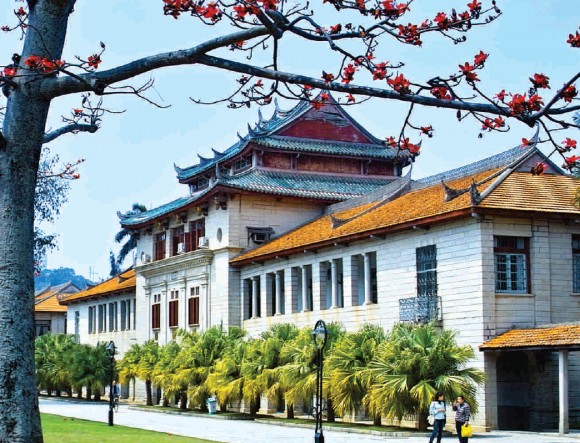A Chapman journey to Xiamen University, assisted by the Kay family, explores opportunities for exchange of students and faculty.
Creating an environment for students to become global citizens is an integral part of the Chapman University mission. Hundreds of students annually participate in study abroad programs, and Chapman has been the academic home to students from more than 60 nations. The goal of inspiring Chapman global citizens took another step forward this spring.

Chapman Chancellor Daniele Struppa led a small contingent to China to visit Xiamen University in the western port city for which it is named.
“We have explored collaborative opportunities with universities in other countries, including China, in the past but with mixed results. I believe Xiamen University has great promise for success,” Struppa said.
The relationship has enhanced potential, the chancellor said, because it has a catalyst in Chapman alumnus Elim Kay ’09. Struppa explained that “like in any other negotiation, each side has goals and parameters that can get in the way of success. Having the Kay family provide the introduction between Xiamen and Chapman and serve as a bridge to solve potential roadblocks allowed for productive sessions with officials of the university.”
Kay, a member of Chapman’s Board of Governors, believes that his Chapman education has been an important part of his life and that an opportunity to enhance the education of future generations with a global and cultural understanding is simply “paying it forward.”
The Kay familys’ willingness to broker a relationship between Chapman and Xiamen leadership went beyond ceremony. Elim Kay is fluent in Chinese and had visited Xiamen University previously. Knowing the administrations of both universities provided more than an exchange of language, it also provided a deep cultural understanding of all involved.
 The trip to Xiamen included visits to all three Xiamen campuses. The original campus opened, much like Chapman, as a private university in 1921. The original campus houses the School of Management, College of Economics, School of Mathematics and several other programs. A ferryboat ride across Xiamen Bay brought the group to the second campus, which includes schools of medicine, nursing, pharmaceuticals and other sciences.
The trip to Xiamen included visits to all three Xiamen campuses. The original campus opened, much like Chapman, as a private university in 1921. The original campus houses the School of Management, College of Economics, School of Mathematics and several other programs. A ferryboat ride across Xiamen Bay brought the group to the second campus, which includes schools of medicine, nursing, pharmaceuticals and other sciences.
While the main campus winds along a hillside overlooking the coast of Xiamen Bay, a third campus, on which construction began in 2011 and is already hosting classes, is laid out on a single, massive plain — fresh, stately and symmetrical. The new campus, referred to as TKK University, was built at a seemingly extraordinary pace and completed in about two years. TKK houses a variety of technical programs, including a film school.
Xiamen University officials were affable hosts, ensuring that Chapman travelers went beyond the university grounds with visits to historic Gulangyu Island, also known as Piano Island, and a daylong trip into the countryside to visit the Fujian Mountain District.
Piano Island is home to both a great tradition of pianists and a piano museum. A short ferry ride from the university main campus, the island serves as a local tourist attraction as well as an homage to the piano in all its variations.
The Fujian Mountain District is the site of the Hakka Earthen Buildings, ancient earthen homes, some of which are 600 years old. Incredibly, many of the round fortress-like structures are still home to hundreds of rural Chinese.
After returning to campus, Struppa provided some ideas on how a Xiamen/Chapman partnership might be shaped. Initially, there are two areas that could prove beneficial to both institutions: faculty exchange and a joint educational degree program.
An exchange between the institutions’ faculty members could include a VIP, or visiting international professor. A Xiamen professor could locate in Orange for a year, immersing in the U.S. culture while teaching full-time at Chapman and providing students with both academic and cultural insights.
Student exchange is another critical opportunity that a Xiamen/Chapman partnership could accomplish. One potential scenario is a “3 +1” program in which Xiamen students would receive their initial three years of undergraduate study in China and, based on qualification, language skills, academic achievement, etc., would then move to Chapman for a final year of study. As a result, the students could qualify for a degree issued jointly by Xiamen and Chapman.
In both the faculty and student exchange programs, many details would still need agreement, including synchronization of academic programs, academic qualifications and language proficiency requirements. Xiamen has taken a progressive step regarding language; already a significant number of Xiamen University classes are taught in English. Many of Xiamen’s current faculty have either studied or taught in the U.S., and some have done both. An example is the current Xiamen dean of economics, Yongmiao Hong, Ph.D., who is also a professor at Cornell.
Old Towne in Orange has its own special character, and the prospect of connecting Chapman’s home with the history of Fujian’s earthen houses is one more reason that an academic and cultural exchange between Xiamen and Chapman could create a new educational opportunity of extraordinary depth. Thanks to a thoughtful Chapman alumnus, education has the opportunity to unite all involved as global citizens.





Add comment